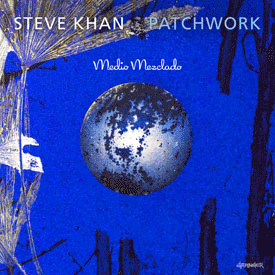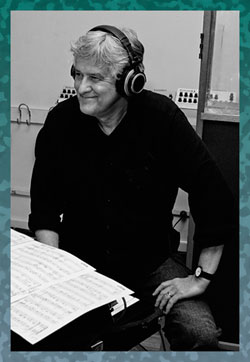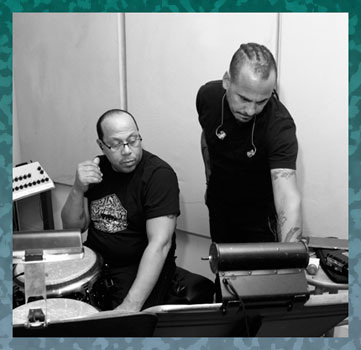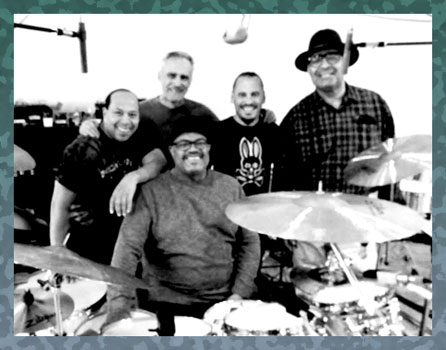

|
Soundclip:
|
| See Steve's Hand-Written Lead Sheet |
|
Steve Khan's Lead Sheet for: "Naan Issue"(Steve Khan) In 2017, on "BACKLOG" there were no original tunes from me, and so, nothing appeared at KHAN'S KORNER 2. This was not exactly a joyous development. That is a certainty. When that album ended its run, I was pretty certain that I was never going to be able to find a way to record again. Aside from all the practical considerations,  I had no music, no vision of pieces that I wanted to interpret, and worse than that, I had no new tunes.
I had no music, no vision of pieces that I wanted to interpret, and worse than that, I had no new tunes.As I have never been the kind of artist or composer who stockpiles tunes around my apartment, there is never a surplus of material, original tunes, to draw upon. When I do record, what goes on the most recent album is everything that I had. When I was preparing for this new recording, I tried to compose some kind of an original blues. How hard could that be? Well, for me, it wasn't so easy. How is it possible that I couldn't even compose an acceptable blues?!?!?! What the hell was wrong with me? I was so frustrated, and very angry with myself. But, one day, I was trying to come-up with an interesting teaching strategy for a particular student of mine, who has always been a blues player, and we have been trying to expand his vocabulary in that area. I don't know how it happened, but my mind and memory drifted back to Wes Montgomery and his original blues in Eb, which was the title song from his 1960 album, "MOVIN' ALONG"(Riverside). At that point, I did not have a cha-cha-cha on this album, and so, I decided that that would be the rhythmic approach for "Naan Issue." Taking Wes' basic chord changes, I laid-out the piece, and eventually came-up with a melody that resonated with me. The harmonies that support the melody, and the last 3 choruses of the solo are all, yet again, Clare Fischer influenced, and required the superb musicianship of Rob Mounsey. The super funky underpinning from Rubén Rodríguez(Baby Bass), Marc Quiñones(Timbal, Güiro & Campana), Bobby Allende(Conga), and Dennis Chambers(Drums) is, as always, priceless to me. Fortunately for me, hearing beautiful harmonies has always been the easiest part of my particular compositional process. Having a structure, a form, and a set of chord changes laid out in front of me, arranging something that sounded right to me, given all of these 7(9sus) chordal sonorities, flowed reasonably easily. Wes Montgomery's tune was a traditional 12 bars, but because of the nature of this particular rhythmic approach, "Naan Issue" became 24 bars. As I wanted to have an Intro for the tune, I simply used the chords from bars 17-20, playing those 4 bars twice, and then adding a 2-bar percussion break, and the tune would begin there. Having now posted the KEYBOARD LEAD SHEETS for a couple of the tunes from "BACKLOG," it becomes important to do the same for three of the tunes from "PATCHWORK." On my original Protools demo for "Naan Issue," I played all of these parts myself, knowing that, eventually the great Rob Mounsey  would take care of really bringing them to life. The keyboard influences for me are pretty much always the same, you could say that you hear bits and pieces of the aforementioned Clare Fischer, or McCoy Tyner, Chick Corea and Herbie Hancock. They're all in there somewhere, somehow. would take care of really bringing them to life. The keyboard influences for me are pretty much always the same, you could say that you hear bits and pieces of the aforementioned Clare Fischer, or McCoy Tyner, Chick Corea and Herbie Hancock. They're all in there somewhere, somehow.Hearing a melody that would be at once, interesting and acceptable, was the difficult part, and here, trial and error, and endless frustration were the order of the day! Eventually, I had something that I felt reasonably good about, and finally committed myself to it. Now, after months of having lived with this, I hear that I must have been channeling my inner Don Grolnick, because there are many melodic and rhythmic twists that remind me of some of his wonderful melodies. On the past two albums, thanks to Rob Mounsey's clever suggestion, we had decided to color the melodies to both Greg Osby compositions, "Heard" from "SUBTEXT" and "Concepticus in C" from "BACKLOG" with the sounds of the piccolo and bass clarinet. For some reason, on this recording, I now feel that this is the best that we have gotten this blend to sound. There were moments where I was very worried that my guitar was in too low of a register to speak well in such a setting, but now, I have come to hear the three instruments as one blend, and that's as it should be. It is a bit ironic that on Wes Montgomery's "Movin' Along" his melody is doubled by Texas flautist James Clay. Where the melody, any melody is concerned, my hope would always be that it is singable - though it might take some time for some people to feel that they could sing it. So, even if a melody might have some complexities, in terms of the pitches or the rhythms, it would be nice if it was memorable in some way. Considering that there are 7 notes in any of the modes, and here, over our I7 chord of Eb7(9sus), where I am thinking of it as Bb Dorian [Bb. C, Db, Eb, F, G, Ab], one should be quick to realize that any one of those 7 notes has been written and played a million times by those who have come before. So, on a basic level, it would be easy to talk yourself out of writing down any one note, anything for fear that you are only writing something that has already been done. But, you must quickly get over that, and just write what you hear, and what feels good to you. It is as simple as that - but still and all, not so easy!!! What I ended-up doing in a very thematic way was to use groupings with two 16th-notes and an 8th-note, where the target melodic note was surround by its chromatic upper and lower neighbors. You can hear and see this in bars: 6, 7-8, and 9-10. It is interesting to note that in bar 20, the rhythmic group reverses itself to an 8th-note and two 16th-notes while completing a phrase. As a point of interest, I would confide in you that, originally, my plan was that this melody was to have been repeated, but, as the actual recording was nearing, I realized that I had just about 85-minutes of music! I was in shock for a period of time, and I didn't know what to do, except I did know that a commercial CD, one that is for sale, must be under 78-minutes of total music time, so that there is no risk of having digital errors that might upset someone's listening. That meant that I had to somehow trim down 7-minutes of music.  You can't imagine how hard it is to do that when you have worked so long to get the music to this point. The first thing that I examined was were there any melodic repeats that were in excess, and could be edited out? Where "Naan Issue" was concerned, that was easy, there would be no repeat of the melody at the top! You can't imagine how hard it is to do that when you have worked so long to get the music to this point. The first thing that I examined was were there any melodic repeats that were in excess, and could be edited out? Where "Naan Issue" was concerned, that was easy, there would be no repeat of the melody at the top!As the cha-cha is one of the most easily appealing grooves to non-Latinos and Latinos alike because of its insistent quarter-note feel coming the cha-cha bell on the timbal, it is easy to take for granted the artistry of great, great players like Rubén, Marc, and Bobby. But be assured, my appreciation for their history, and the way that they make things feel today, right now, knows no bounds. They are all giants in the genre. Rubén's huge tumbao and sound anchor a tune like this both harmonically and rhythmically. He becomes the glue between all the elements. When you add in the huge presence and big beat of drummer Dennis Chambers, the rhythmical elements for my senses are all there. Dennis comes at a piece like this bringing with him the elements of R&B and Jazz-Fusion. Having Dennis back for this recording was so huge for me. One element that I always ask of dear Dennis Chambers is to play a particular cymbal pattern that I have loved since I first heard it on Cal Tjader's "Soul Motion" from "SOUL BIRD"(Verve)(1965). On this performance, that pattern became kind of intermittent, still it is an element that I love hearing. We first did this on "Change Agent" from "PARTING SHOT"(2011). One of the most important elements in Latin music is the art of the percussion break, which can occur at any number of moments during a particular tune. This is an element that some non-percussion players are actually capable of writing into their arrangements. I don't feel remotely qualified to do that. So, I count on Marc and Bobby to come-up with the breaks as needed. What they invariably add gives my albums a sabor that they would not have had otherwise. A cha-cha would not be such without Marc's signature avanicos, which happen throughout the piece. The first of the breaks occurs after the melody, and is played underneath Rob's big Rhodes breakdown. From Marc, Bobby and Dennis, it recalls Dizzy Gillespie's classic "Salt Peanuts"! But, in a unique Bobby Allende-created twist, there's a flurry of unison notes that lead directly into the beginning of Solo Chorus 1. Bobby created this break very spontaneously, and then shared it with Marc and Dennis. When it came together, it was fantastic. One other element that I have come to love so much on some cha-chas is the inclusion of the campana at certain moments. During this performance, with my pleading, Marc plays it in the Intro, and it then re-enters during Choruses 4-6 of the solo. I always associate the combination of the campana and the cha-cha bell with Ray Barretto's classic tune, "Cocinando" which I have loved forever - as do many!!! If you are new to this tune, the campana enters when the trumpet solo begins. After the guitar solo ends, the Rhodes breakdown is twice as long, and this time Marc decided that they would play 6/8 against it leading to a levanta which, in English, would simply mean an 8th-note crescendo building into the next section. This is also a classic but perfectly placed device here. The final touch of creative percussion appears in the [Tag] to the tune, in the very last bar,  and this was actually my idea as it is a tribute to one my great Latin music heroes, Willie Bobo. It involves a laid-back triplet figure that relies heavily on the big foot of Dennis Chambers! and this was actually my idea as it is a tribute to one my great Latin music heroes, Willie Bobo. It involves a laid-back triplet figure that relies heavily on the big foot of Dennis Chambers!As I stated earlier, the song form is a 24-bar blues, with all of the chordal sonorities being 7(9sus) sounds. These sonorities, for me, are lush and rich sounds that boast of both romance and fierce pride. What was always wonderful and exciting for me about the blues tunes that Wes Montgomery composed was that there was always some little personal twist somewhere that would make things more interesting than the 'expected.' In his "Movin' Along," that 'twist' came in the last 4 bars. For "Naan Issue," I wouldn't say that there is one particular twist within the composed part of the piece. As I noted, the angular quality of this melody supplies many of the twists, and those twists are answered by the harmonic color provided by Rob's Rhodes voicings. One such color happens on beat 2 of bar 6. Then, of course, I have written into the piece the b5 sub in the second half of bar 8 as we transit from Eb7(sus) to Ab7(sus), and you see A7 there. It begins on the and-of-2, in clave, and continues on beat 4 resolving with a big hit/punctuation on beat 2 of bar 9 by Marc's timbal. From there, the tune really conforms to Wes' solo chord changes, which were wonderful to write over. And, speaking of writing and arranging, when I am fortunate enough to have a timbalero like Marc, who reads so well, I can actually write in for him the rhythms of the melody so that, beyond my suggested accents, he can feel free to color and interpret the tune based upon what feels right to him. It is always exciting for me to hear the end result of what he has chosen to do. His performance here is simply wonderful. For what it's worth, when we do these recordings together, I always bring along two extra cymbals for Marc to use - and, lucky for me, he likes them, so in addition to his normal cymbal, his arsenal is enhanced with a Zildjian 10" splash cymbal and a 17" China cymbal with rivets. For me, extra cymbal colors are just as important as orchestral colors! Earlier I had mentioned Wes Montgomery's fondness for coming up with interesting little twists to blues changes for his own tunes, and here, within "Naan Issue" between bars 17-20, we have just that little point-of-interest. I suppose that one could say that it would be most common to see V7 to IV7 in these bars. But, in "Movin' Along" Wes used the bVI7 to V7. So, as I wrote the tune in the same key as "Movin' Along," you now have F#m7(9sus)/B to Fm7(9sus)/Bb for 2 bars each. By the way, I suppose that I could have just as easily labeled the first chord as Gbm7(9sus)/B These chord changes create something different for the melodic content, and offer an interesting challenge for soloing as well. Another important detail in the compositional process, and perhaps in the art of production, is an ending! On "PATCHWORK," if you count the bonus track, "Nature Boy," there are 5 songs with endings, and 5 with fades.  Philosophically speaking, all tunes should have endings, but, remembering my younger days of inspiration listening to Jazz and other forms of music, I always found something dramatic in the fades on older recordings. Some fades were so riveting to me that, I would turn up my stereo louder and louder to try to get the last little bit of music out of those fades. I would always be left with the burning question: "Wow, I wonder what happened after that? So, where fades are concerned, you should know that everything that you are able to hear - even if you have to go fishing for it - it is something that I, as the producer, meant for you to hear. And then, I would want you to ask the same question that I used ask! On each of the 5 fades, engineer James Farber did a masterful job, as he always does, executing these fades by hand. Prior to doing that, I would show him on the track exactly the moment that I wanted to be the last thing that people would hear. Having a real ending eliminates all of that hard work from the process. For the ending of "Naan Issue," I remember just singing something to myself, then I tried playing it on the guitar, and finally, I programmed it into my original demo. Upon hearing it back, I liked it, and it stuck. On an album like this, where the total music time is way too close to the RED LINE of 78-minutes, in mastering you can save yourself a second or two on the tunes with endings by hoping that a great mastering engineer like Greg Calbi @ Sterling Sound, now in New Jersey, can chase the ring-out a bit, and gain you that precious second. Greg was able to do that on a couple of the endings, but the others would have sounded unnatural had he done that! Philosophically speaking, all tunes should have endings, but, remembering my younger days of inspiration listening to Jazz and other forms of music, I always found something dramatic in the fades on older recordings. Some fades were so riveting to me that, I would turn up my stereo louder and louder to try to get the last little bit of music out of those fades. I would always be left with the burning question: "Wow, I wonder what happened after that? So, where fades are concerned, you should know that everything that you are able to hear - even if you have to go fishing for it - it is something that I, as the producer, meant for you to hear. And then, I would want you to ask the same question that I used ask! On each of the 5 fades, engineer James Farber did a masterful job, as he always does, executing these fades by hand. Prior to doing that, I would show him on the track exactly the moment that I wanted to be the last thing that people would hear. Having a real ending eliminates all of that hard work from the process. For the ending of "Naan Issue," I remember just singing something to myself, then I tried playing it on the guitar, and finally, I programmed it into my original demo. Upon hearing it back, I liked it, and it stuck. On an album like this, where the total music time is way too close to the RED LINE of 78-minutes, in mastering you can save yourself a second or two on the tunes with endings by hoping that a great mastering engineer like Greg Calbi @ Sterling Sound, now in New Jersey, can chase the ring-out a bit, and gain you that precious second. Greg was able to do that on a couple of the endings, but the others would have sounded unnatural had he done that!Of course, we can't avoid talking about the title of this tune. Needless to say, when two people, or two countries are having a discussion about problems between them, and one person/country or the other dismisses an argument for or against something by simply saying: "No, that's a non-issue here!" Or it became a non-issue because one person or the other thought that it had been resolved a long time ago - when, perhaps, in fact, it hadn't been resolved at all. So, given my love for Indian cuisine, making a little play-on-words was easy, and the title became "Naan Issue" named for the delicious bread that is served in most Indian restaurants all over the world.  For the past few years or so, almost every Friday evening, I go to my favorite neighborhood Indian restaurant, sit at a quiet table in the back and enjoy a delicious meal of their chicken curry accompanied by some naan. What a treat, what a delight for one's taste buds. So there you have it, a long story, for a short title. For the past few years or so, almost every Friday evening, I go to my favorite neighborhood Indian restaurant, sit at a quiet table in the back and enjoy a delicious meal of their chicken curry accompanied by some naan. What a treat, what a delight for one's taste buds. So there you have it, a long story, for a short title.As it always is, a recording like this is a group effort, a joining together of all the various talents and personalities. No matter what the past chemistry might have been, everything becomes tied to the moment. Each player brings a world, a lifetime of experience to this table, and without the input from Rob, Rubén, Marc, Bobby and Dennis, this tune would never have become what it now sounds and feels like. There are certainly never any perfect mixes, there are always going to be little details that are going to drive me nuts for eternity, but there comes a moment when you just have to let the tune go, and allow it to be what it is. Because it felt like the most simple of the pieces, "Naan Issue" was the first thing that we recorded on March 18th, 2019. The group photo that you see here was hastily thrown together by me - and it was taken by an assistant engineer the day before Rick Laird was going to come and take the more serious photos. I love the feeling of the photo as we surrounded Dennis at the drums - the only problem was that the assistant didn't know how to use the focus function on my stupid camera, and the shot is blurry - but, I still wanted to share it here.
[Photos: Rob Mounsey; Rubén Rodríguez, Marc Quiñones and Bobby Allende
@ Sear Sound, New York by Richard Laird Out of Focus Group Photo - Steve's Camera | Photographer Unknown! Chicken Curry with Naan @ Alachi Masala, NYC - by Steve and his same stupid camera!] |